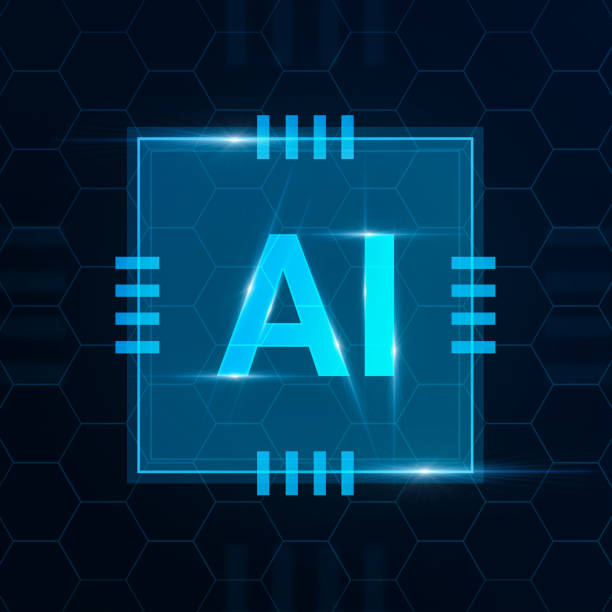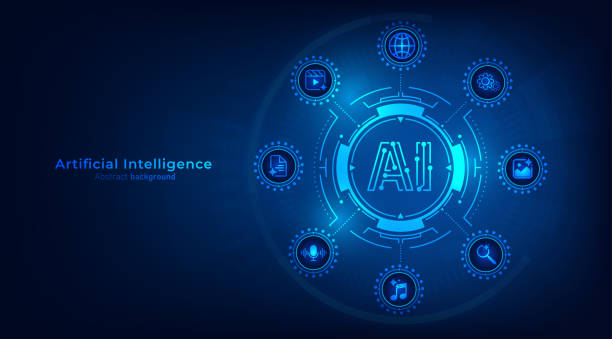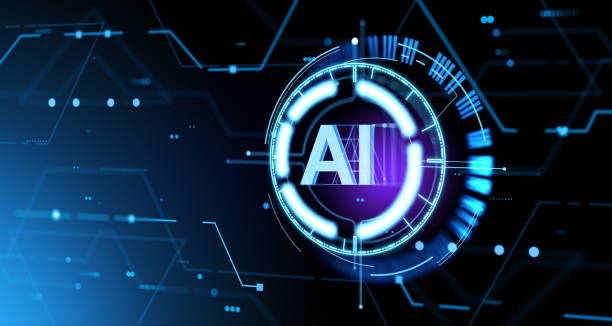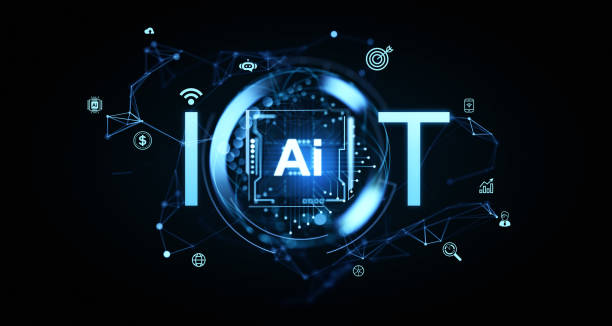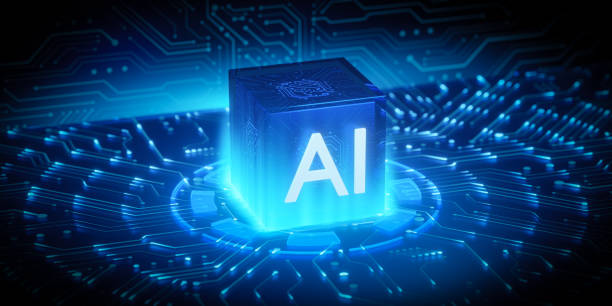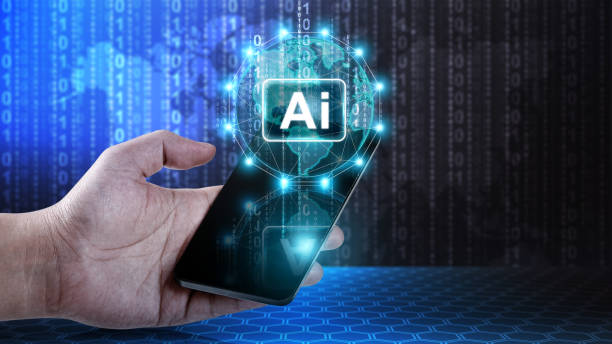What is Artificial Intelligence and what does it mean? Fundamental Definition
What is Artificial Intelligence and what does it mean? Fundamental Definition
#Artificial_Intelligence or #AI, is a branch of computer science that deals with building machines and systems capable of performing tasks that usually require human intelligence.
These tasks include learning, reasoning, problem-solving, understanding natural language, pattern recognition, and decision-making.
In other words, artificial intelligence tries to simulate human mental abilities in machines.
Artificial intelligence is not only limited to building humanoid robots, but also includes a wide range of technologies and algorithms that are used in various fields.
These applications include recommender systems in online stores and social networks, self-driving cars, facial recognition, natural language processing (NLP), and virtual assistants such as Siri and Alexa.
In fact, artificial intelligence, using data and complex algorithms, tries to identify patterns and make decisions based on them.
This process allows machines to learn and improve automatically without the need for explicit programming for each situation.
This machine learning capability is one of the most important features of artificial intelligence.
With the ever-increasing advancement of technology, artificial intelligence has increasingly penetrated our lives and is expected to play a much more important role in various industries and everyday life in the near future.
From medicine and healthcare to transportation and finance, artificial intelligence has the potential to fundamentally change and transform many fields.
Are you frustrated with the low conversion rate of your online store? Rasaweb turns your online store into a powerful tool for attracting and converting customers!
✅ Significantly increased visitor-to-buyer conversion rate
✅ Unparalleled user experience to increase customer satisfaction and loyalty⚡ Get free advice from Rasaweb!
History and key developments of artificial intelligence from beginning to today
History and key developments of artificial intelligence from beginning to today
The idea of building machines that can think dates back to ancient times, but the modern concept of artificial intelligence took shape in the mid-twentieth century.
In 1956, a conference was held at Dartmouth College that is officially recognized as the beginning of the field of artificial intelligence.
At this conference, prominent researchers such as John McCarthy and Marvin Minsky gathered and explored the possibility of building intelligent machines.
In the early decades, artificial intelligence was accompanied by great hopes, and researchers made significant progress in areas such as problem-solving and game development (such as chess).
However, the limitations of these approaches soon became apparent.
Early artificial intelligence systems were often fragile and could not cope well with the complexities of the real world.
This period is known as the “AI winter,” when interest and research funding in the field declined.
In the 1980s and 1990s, with the emergence of machine learning and especially neural networks, artificial intelligence was once again attracting attention.
Neural networks, which are inspired by the structure of the human brain, have the ability to learn from data and can identify complex patterns.
These advances led to the development of smarter systems that could perform more complex tasks.
In recent years, with the increase in computing power and access to big data, artificial intelligence has achieved remarkable progress.
Deep learning algorithms, which are a type of neural networks, have been able to achieve extraordinary results in areas such as image recognition, natural language processing, and machine translation.
Today, artificial intelligence has become one of the most popular and important research areas in computer science and is expected to continue to grow and develop in the future.
Types of Artificial Intelligence from limited to general intelligence
Types of Artificial Intelligence from limited to general intelligence
Artificial intelligence can be divided into several main categories based on their capabilities and scope of application:
- Narrow or Weak AI This type of artificial intelligence is designed to perform specific tasks and performs well only in that area.
Most artificial intelligence systems we use today are of this type.
Examples of limited artificial intelligence include facial recognition systems, recommender systems, and virtual assistants such as Siri and Alexa. - General or Strong AI This type of artificial intelligence has cognitive abilities similar to humans and can perform any task that a human can do with the same level of skill and efficiency.
General artificial intelligence is still in the research stage and no complete general artificial intelligence system has been built so far. - Super AI This type of artificial intelligence surpasses human intelligence and can perform better than humans in all fields.
Super artificial intelligence is still a hypothetical concept and does not exist at present.
In practice, most artificial intelligence research and development focuses on limited artificial intelligence, as achieving general and super artificial intelligence involves many technical and theoretical challenges.
However, some researchers believe that with the ever-increasing advances in artificial intelligence, achieving general artificial intelligence will be possible in the not-too-distant future.
| Type of Artificial Intelligence | Description | Examples |
|---|---|---|
| Limited Artificial Intelligence (Weak AI) | Designed to perform specific tasks | Facial recognition systems, virtual assistants |
| General Artificial Intelligence (Strong AI) | Has cognitive abilities similar to humans | (Still in the research stage) |
| Super Artificial Intelligence (Super AI) | Exceeds human intelligence | (Hypothetical concept) |
Click here to preview your posts with PRO themes ››
To better understand the difference between these types of #artificial_intelligence, they can be considered as different levels of intelligence.
Limited artificial intelligence is like an expert in a specific field, while general artificial intelligence is like an intelligent person who can learn and act in different fields.
Super artificial intelligence is like a genius who has the ability to solve complex problems at a speed beyond human capabilities.
Extensive applications of artificial intelligence in various industries from medicine to transportation
Extensive applications of artificial intelligence in various industries from medicine to transportation
Artificial intelligence currently has widespread applications in various industries and is constantly being developed and expanded.
Some of the most important applications of artificial intelligence include:
- Medicine and Healthcare Diagnosing diseases, developing drugs, robotic surgery, managing hospitals, and providing personalized healthcare.
- Transportation Self-driving cars, optimizing routes, managing traffic, and improving transportation safety.
- Finance Fraud detection, risk management, automated investment, and providing personalized financial services.
- Manufacturing Optimizing production processes, quality control, predicting failures, and industrial robots.
- Education Personalized education, automated assessment, and development of educational content.
- Customer Service Chatbots, answering customer questions, and providing technical support.
- Marketing Analyzing customer behavior, targeted advertising, and optimizing marketing campaigns.
These are just a few examples of the countless applications of artificial intelligence.
With the ever-increasing advancement of technology, artificial intelligence is expected to play a much more important role in various industries and everyday life in the future.
For example, in the field of medicine, artificial intelligence can help doctors diagnose diseases more accurately and quickly, and in the field of transportation, self-driving cars can increase road safety and reduce traffic.
In fact, artificial intelligence has the potential to create fundamental changes in many industries and can help improve productivity, reduce costs, and provide better services to customers.
However, the development and use of artificial intelligence also comes with challenges, which we will address below.
Are you bothered by losing customers who have visited your site to make a purchase?
Rasaweb is your specialized solution for having a successful online store.
✅ Significantly increase your online sales
✅ Create trust and professional branding among customers⚡ Get free advice from Rasaweb experts!
Machine Learning The Driving Force of Artificial Intelligence
Machine Learning The Driving Force of Artificial Intelligence
Machine Learning is a subset of artificial intelligence that allows machines to learn from data and identify patterns without the need for explicit programming.
In fact, machine learning gives machines the ability to improve their performance through experience.
There are different types of machine learning algorithms, each suitable for a particular type of problem.
Some of the most common types of machine learning algorithms include:
- Supervised Learning In this type of learning, the machine is trained using labeled data.
Labeled data includes inputs and desired outputs.
The goal of supervised learning is to create a model that can predict the correct outputs for new inputs. - Unsupervised Learning In this type of learning, the machine is trained using unlabeled data.
The goal of unsupervised learning is to discover hidden patterns and structures in the data. - Reinforcement Learning In this type of learning, the machine learns how to achieve a specific goal by interacting with an environment.
By taking different actions in the environment and receiving feedback (reward or punishment), the machine learns which actions produce the best results.
Machine learning is used in various fields, including:
- Image recognition
- Natural language processing
- Predicting customer behavior
- Fraud detection
- Recommending products
In fact, machine learning acts as the driving force of #artificial_intelligence and enables the construction of smarter systems.
With the ever-increasing advancement of machine learning algorithms and the increase in access to data, the applications of artificial intelligence are expected to expand in the future as well.
Natural Language Processing Understanding and Production of Human Language by Machines
Natural Language Processing Understanding and Production of Human Language by Machines
Natural Language Processing (NLP) is a branch of artificial intelligence that allows machines to understand, interpret, and produce human language.
NLP is a combination of computer science, linguistics, and statistics, and its goal is to create systems that can interact with humans in natural language.
Some of the most important applications of natural language processing include:
- Machine Translation Automatic translation of text from one language to another.
- Sentiment Analysis Detection of emotions and opinions present in the text.
- Text Summarization Generating a short and accurate summary of a long text.
- Question Answering Answering questions asked in natural language.
- Chatbots Creating chatbots that can interact with humans.
- Speech Recognition Converting speech to text.
- Text Generation Automatic text generation, such as news articles or product descriptions.
Natural language processing comes with many challenges because human language is very complex and ambiguous.
For example, a word may have different meanings, and the meaning of a sentence may depend on its context.
However, with recent advances in deep learning, NLP has made remarkable progress, and today NLP systems can perform complex tasks with high accuracy.
Natural language processing plays a very important role in the development of intelligent systems and enables easier and more natural interaction between humans and machines.
With the increasing use of virtual assistants, chatbots, and other NLP-based systems, the importance of this field is expected to increase in the future as well.
Click here to preview your posts with PRO themes ››
Deep Neural Networks The Backbone of Modern Artificial Intelligence
Deep Neural Networks The Backbone of Modern Artificial Intelligence
Deep Neural Networks (DNNs) are a type of neural networks that consist of multiple Hidden Layers.
These hidden layers allow deep neural networks to identify more complex patterns in the data and perform more complex tasks.
Deep neural networks are inspired by the structure of the human brain and consist of processing units called neurons that are connected in layers.
Each neuron receives an input, processes it, and produces an output.
The output of each neuron is used as the input for the neurons in the next layer.
Deep neural networks are used in various fields, including:
- Image recognition
- Natural language processing
- Speech recognition
- Game development
One of the most important advantages of deep neural networks is that they can automatically learn important features from data.
In traditional machine learning methods, it was necessary for engineers to extract features manually, but deep neural networks can do this automatically.
This makes deep neural networks very suitable for solving complex problems where their important features are not easily identifiable.
Deep neural networks act as the backbone of modern #artificial_intelligence and enable the construction of smarter systems.
With the ever-increasing advancement of technology and the increase in computing power, deep neural networks are expected to play a much more important role in the development of artificial intelligence in the future.
Challenges and limitations of artificial intelligence from ethics to bias
Challenges and limitations of artificial intelligence from ethics to bias
Despite the remarkable progress in the field of artificial intelligence, this technology comes with numerous challenges and limitations.
Some of the most important of these challenges include:
- Ethical Issues The use of artificial intelligence in important decision-making, such as hiring, granting loans, and judgment, can lead to discrimination and injustice.
Also, the use of artificial intelligence in autonomous weapons raises serious concerns about the ethics of war and accountability. - Bias Artificial intelligence systems may learn and reinforce biases present in training data.
This can lead to unfair and discriminatory decision-making. - Transparency Many artificial intelligence systems, especially deep neural networks, are very complex and difficult to understand how they work.
This lack of transparency can reduce trust in these systems and make accountability difficult. - Security Artificial intelligence systems may be vulnerable to cyber attacks, and hackers can exploit these vulnerabilities to manipulate or abuse these systems.
- Impact on Employment Automation caused by artificial intelligence can lead to job losses in some industries.
This can have serious social and economic consequences.
| Challenge | Description |
|---|---|
| Ethical Issues | Discrimination, autonomous weapons |
| Bias | Reinforcing bias in data |
| Transparency | Difficulty in understanding system performance |
| Security | Vulnerability to cyber attacks |
| Impact on Employment | Automation and job loss |
To address these challenges, policymakers, researchers, and artificial intelligence developers need to work together to develop solutions to ensure the responsible and ethical use of this technology.
These solutions should include establishing ethical standards, developing fairer algorithms, increasing system transparency, and training the workforce to adapt to changes caused by artificial intelligence.
Are you tired of your online store website not being able to generate revenue as much as its potential? Rasaweb, a specialist in professional online store website design, solves this problem forever!
✅ Increased sales and revenue
✅ High loading speed and unparalleled user experience
⚡ Get free website design advice
The Future of Artificial Intelligence What Can We Expect?
The Future of Artificial Intelligence What Can We Expect?
Artificial intelligence is rapidly advancing and is expected to play a much more important role in our lives in the future.
Some of the most important expectations we can have for the future of artificial intelligence include:
- Expanding Applications Artificial intelligence will expand in various industries and will be used in new fields such as agriculture, energy, and the environment.
- Improving Performance Artificial intelligence systems will improve in various tasks, and their accuracy and efficiency will increase.
- Developing General Artificial Intelligence With further advances in machine learning and cognitive science, we may see the development of general artificial intelligence.
- More Natural Interaction Artificial intelligence systems will interact with humans more naturally and easily.
- Personalization Services and products based on artificial intelligence will be increasingly personalized and will meet the specific needs of each individual.
However, the future of artificial intelligence is also accompanied by uncertainties.
Some of the important questions that need to be answered include:
- How can we ensure the ethical and responsible use of artificial intelligence?
- How can we prevent bias in artificial intelligence systems?
- How can we manage the impact of artificial intelligence on employment?
- How can we protect artificial intelligence systems from cyber attacks?
Answering these questions requires cooperation between policymakers, researchers, developers, and society.
By adopting a responsible and forward-looking approach, we can benefit from the immense potential of artificial intelligence to improve human lives and prevent its potential dangers.
The future of artificial intelligence looks bright and promising.
With the ever-increasing advances in this field, we can expect artificial intelligence to create fundamental changes in many aspects of our lives in the coming years.
Artificial Intelligence offers countless opportunities to solve complex problems and improve the quality of life.
Click here to preview your posts with PRO themes ››
How to Learn Artificial Intelligence? Resources and Learning Paths
How to Learn Artificial Intelligence? Resources and Learning Paths
If you are interested in learning artificial intelligence, a variety of resources and learning paths are available to you.
Some of these resources include:
- Online Courses Online learning platforms such as Coursera, edX, Udacity, and DataCamp offer a variety of courses in artificial intelligence.
These courses are usually taught by university professors and industry experts and can provide a strong foundation for learning artificial intelligence. - Books There are many books on artificial intelligence that can help you learn different concepts and algorithms.
Some famous books in this field include “Artificial Intelligence A Modern Approach” and “Deep Learning”. - Scientific Articles Reading scientific articles can help you understand the latest advances in the field of artificial intelligence.
Scientific articles are usually published in reputable journals and conferences. - Practical Projects Doing practical projects can help you learn how to use artificial intelligence in solving real problems.
You can start projects from scratch or participate in open-source projects. - Online Forums and Groups Joining online forums and groups can help you connect with other artificial intelligence enthusiasts and learn from their experiences.
To start learning artificial intelligence, you can familiarize yourself with basic concepts such as machine learning, neural networks, and natural language processing.
Then you can focus on a specific area, such as image recognition, natural language processing, or robotics.
You can also start implementing artificial intelligence algorithms using programming languages such as Python and artificial intelligence libraries such as TensorFlow and PyTorch.
Remember that learning artificial intelligence requires patience, perseverance, and continuous effort.
By using the right resources and learning paths, you can succeed in this field and become one of the #artificial_intelligence experts.
Frequently Asked Questions
| Question | Answer |
|---|---|
| What is the definition of Artificial Intelligence (AI)? | It is a field in computer science that aims to create intelligent machines that can think, learn, solve problems, and make decisions like humans. |
| Mention some common applications of AI. | These include self-driving cars, voice assistants (such as Siri and Alexa), recommendation systems (such as Netflix and Amazon), facial recognition, and medical diagnosis. |
| What is the difference between Narrow AI (ANI) and General AI (AGI)? | Narrow AI is specialized in a single and specific task, while General AI has a human intellectual ability to perform any cognitive task. |
| What is Machine Learning and its relationship to AI? | Machine learning is a branch of artificial intelligence that focuses on developing algorithms that allow systems to learn from data without explicit programming. |
| What are Artificial Neural Networks? | They are computational models inspired by the structure and function of the human brain, and are used in deep learning to process data and discover complex patterns. |
| Mention some ethical challenges related to AI. | These include issues of privacy, bias in data and algorithms, job loss, and responsibility in case of errors or unfair decisions. |
| What is Natural Language Processing (NLP)? | It is a branch of artificial intelligence that focuses on enabling computers to understand, interpret, and create human language in a useful and interactive way. |
| How can AI affect the labor market? | It can lead to the automation of some routine tasks, which requires the rehabilitation of workers and the creation of new jobs in the fields of design, development, and maintenance of AI systems. |
| What is Computer Vision? | It is a field in artificial intelligence that enables computers to “see” and understand and interpret images and videos in the same way that humans do, enabling them to recognize objects and faces. |
| What is the importance of data in the development of AI systems? | Data is the fuel that feeds artificial intelligence systems, especially in machine learning. The quality and quantity of data greatly affect the accuracy and performance of models and their ability to learn and make correct decisions. |
And other advertising services of Rasa Web Advertising Agency in the field of advertising
Intelligent Content Strategy: A combination of creativity and technology to increase click-through rates with a SEO-oriented content strategy.
Intelligent Content Strategy: Transform user interaction with the help of accurate audience targeting.
Intelligent Reportage: An effective tool for digital branding with the help of optimizing key pages.
Intelligent UI/UX: A creative platform for improving campaign management with accurate audience targeting.
Intelligent Digital Branding: Professional optimization to increase sales using Google ad management.
And more than hundreds of other services in the field of internet advertising, advertising consulting, and organizational solutions
Internet Advertising | Advertising Strategy | Advertising Report
Resources
Applications of artificial intelligence in everyday life
, What is artificial intelligence and how does it work?
, Applications of artificial intelligence in various industries
, Benefits of using artificial intelligence
? Are you ready to transform your business in the digital world? Reach the peak of success with Rasaweb Aferin, a specialist in SEO website design and comprehensive digital marketing strategies.
📍 Tehran, Mirdamad Street, next to the Central Bank, South Kazerun Alley, Ramin Alley, No. 6



